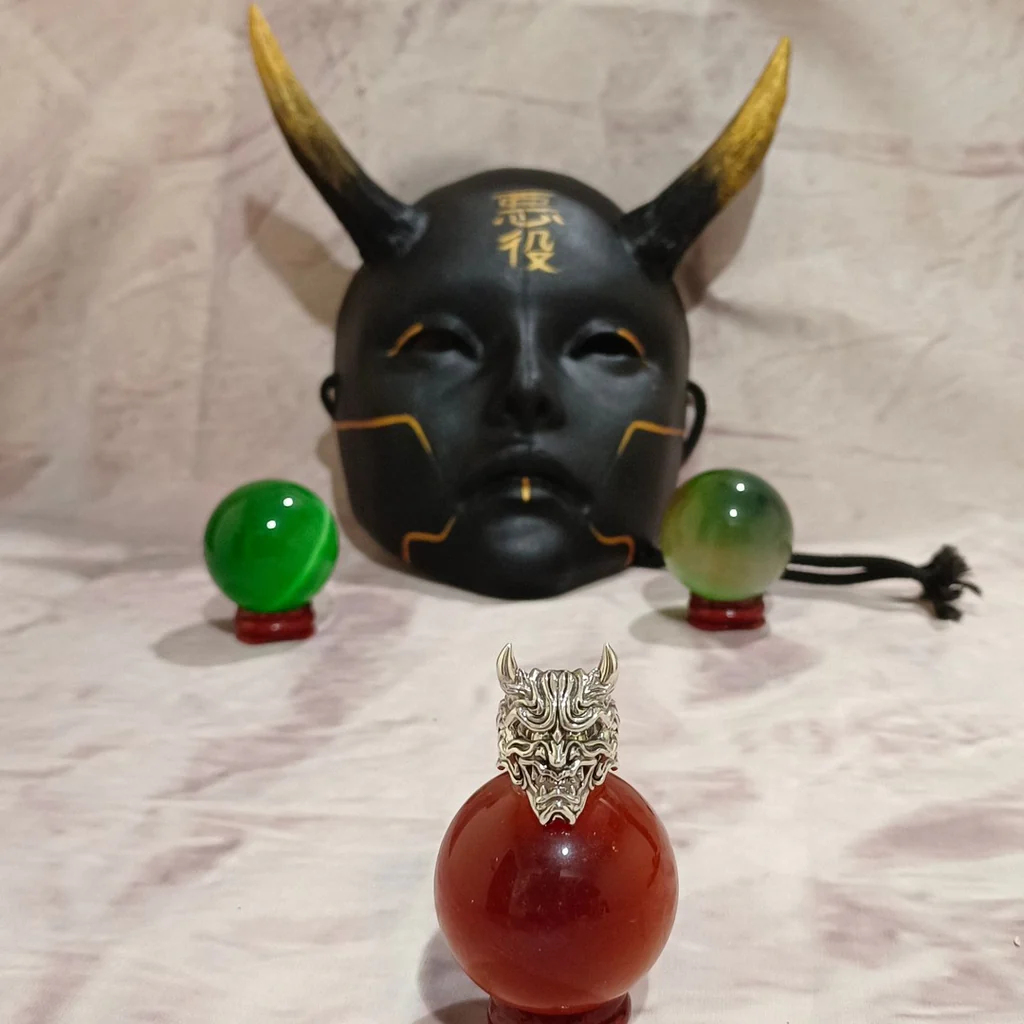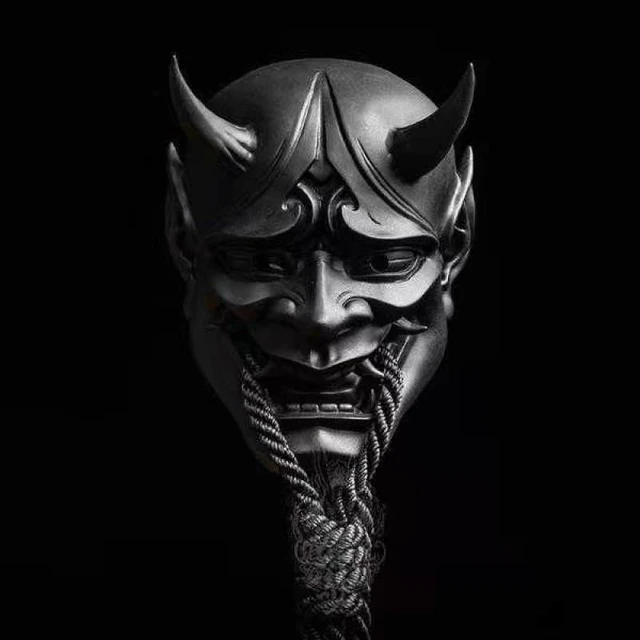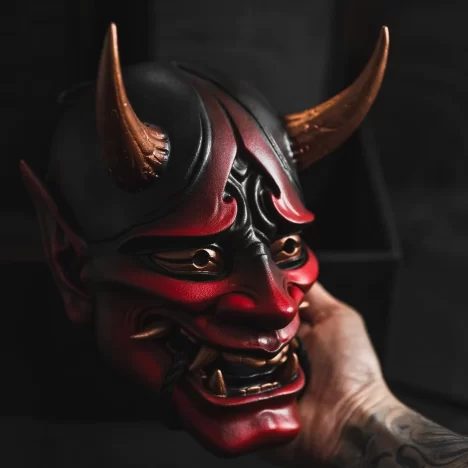The Hannya mask, a captivating and unsettling visage, is a cornerstone of Japanese Noh theater. It embodies the wrathful spirit of a woman consumed by jealousy, rage, and transformation. More than just a theatrical prop, the Hannya mask is a window into Japanese folklore, emotions, and artistic expression. This article delves into the history, symbolism, and enduring legacy of this iconic mask.

Contents
- 1 Origins and Symbolism
- 2 Evoking Emotions Through Minimalism
- 3 Variations in the Hannya Mask
- 4 Beyond Noh: The Hannya Mask’s Cultural Impact
- 5 A Mask for Modern Times
- 6 Crafting the Mask: A Dying Art
- 7 Facial expressions and emotions depicted
- 8 Different types and styles of Hannya masks
- 9 The Hannya Mask: A Legacy of Performance and Emotion
Origins and Symbolism
The Hannya mask’s origins can be traced back to Noh, a traditional Japanese theatrical form that emerged in the 14th century. Noh plays often explore themes of love, loss, and the supernatural. The Hannya mask specifically portrays a character known as an “onryo,” a vengeful spirit typically a woman who died due to heartbreak or betrayal. These onryo are consumed by intense emotions, particularly jealousy and rage, which manifest in their monstrous transformation.
The design of the Hannya mask is as striking as its backstory. Crafted from wood, the mask features a ferocious expression. Wide, hollow eyes, often gleaming gold, pierce the viewer. A gaping mouth reveals sharp teeth and a contorted tongue, a physical manifestation of the wearer’s inner turmoil. Two horns, reminiscent of a bull, sprout from the mask’s forehead, symbolizing the wearer’s loss of humanity and descent into demonic rage.

Evoking Emotions Through Minimalism
Noh theater is known for its understated style, relying heavily on symbolism and suggestion to convey emotions. The Hannya mask perfectly embodies this philosophy. Despite its lack of realistic features, the mask’s exaggerated expressions and sharp lines effectively communicate the wearer’s intense emotions. The stark contrast between the mask’s unnatural colors and a performer’s human movements creates a sense of unease and disharmony, further emphasizing the onryo’s state of being.
Variations in the Hannya Mask
While the core design of the Hannya mask remains consistent, subtle variations exist. The angle of the horns, the shape of the eyes, and the severity of the grimace can all differ depending on the mask maker and the specific Noh play. These variations allow for a nuanced portrayal of the onryo’s character. A mask with a wider mouth and more pronounced teeth might represent a more violent and vengeful spirit, while a mask with narrower eyes and a subtler grimace could suggest a deeper sadness underlying the rage.

Beyond Noh: The Hannya Mask’s Cultural Impact
The Hannya mask’s influence extends far beyond Noh theater. It has become a recognizable symbol of jealousy and rage in Japanese culture. The mask frequently appears in Kabuki theater, another traditional Japanese theatrical form, though its use in Kabuki is often more stylized and less focused on psychological depth. The Hannya mask has also found its way into popular culture, appearing in video games, anime, and even tattoos.
A Mask for Modern Times
The Hannya mask’s enduring popularity speaks to its ability to resonate with audiences across cultures and time periods. While its origins lie in a specific historical context, the emotions it represents – jealousy, rage, and the struggle between human and monstrous natures – remain universally relatable. In today’s world, where social media and a hyper-connected environment can fuel feelings of jealousy and resentment, the Hannya mask serves as a powerful reminder of the destructive potential of these emotions.

Crafting the Mask: A Dying Art
The creation of Hannya masks is a specialized skill passed down through generations of artisans. The traditional process involves meticulous carving of wood, followed by painstaking application of paint and lacquer. Sadly, this art form faces challenges in the modern world. The time and skill required to create a high-quality Hannya mask make them expensive, and fewer young people are interested in learning the craft. Efforts are underway to preserve this cultural heritage, with workshops and programs dedicated to teaching the next generation of Hannya mask makers.
Facial expressions and emotions depicted
The Hannya mask, despite its lack of realistic features, is a masterclass in conveying emotions through a minimalist design. Here’s a breakdown of the key facial expressions and the emotions they depict:
Wide, Hollow Eyes:
These often gleaming gold eyes pierce the viewer, creating a sense of intensity and possibly even madness. They suggest the onryo’s relentless focus on the object of their rage or the obsession driving their vengeful spirit.
Gaping Mouth:
The gaping mouth reveals sharp teeth and a contorted tongue, a physical manifestation of the wearer’s inner turmoil. It signifies the onryo’s unrestrained anger and the urge to lash out verbally or even physically.
Exaggerated Grimace:
The entire mask contorts into a grimace, a combination of a frown and a snarl. This distortion emphasizes the onryo’s complete transformation from a human consumed by emotions.
Horns:
The horns themselves are a symbol of rage and demonic possession. Their presence signifies the onryo’s loss of humanity and descent into a vengeful being.
Combined Effect:
When these individual elements come together, they create a powerful image of a being consumed by jealousy, rage, and a thirst for revenge.

Different types and styles of Hannya masks
While there’s a core design for the Hannya mask, there are subtle variations that exist depending on the mask maker and the Noh play it’s used in. These variations allow for a nuanced portrayal of the onryo’s character.
- Angle of the Horns
- Straight horns: Can represent a more vengeful spirit.
- Shape of the Eyes
- Narrow eyes: Suggest a deeper sadness underlying the rage.
- Severity of the Grimace
- Wider mouth and more pronounced teeth: Might represent a more violent and vengeful spirit.
The Hannya Mask: A Legacy of Performance and Emotion
The Hannya mask is more than just a theatrical prop; it is a captivating symbol of jealousy, rage, and the dark side of human nature. Its expressive design and nuanced variations allow Noh performers to convey complex emotions with remarkable efficiency. The mask’s cultural impact extends beyond theater, finding its way into popular culture and serving as a reminder of the timeless struggle between human and monstrous emotions. As efforts continue to preserve the art of Hannya mask making, this powerful symbol of the Noh tradition ensures its legacy will endure for generations to come.
